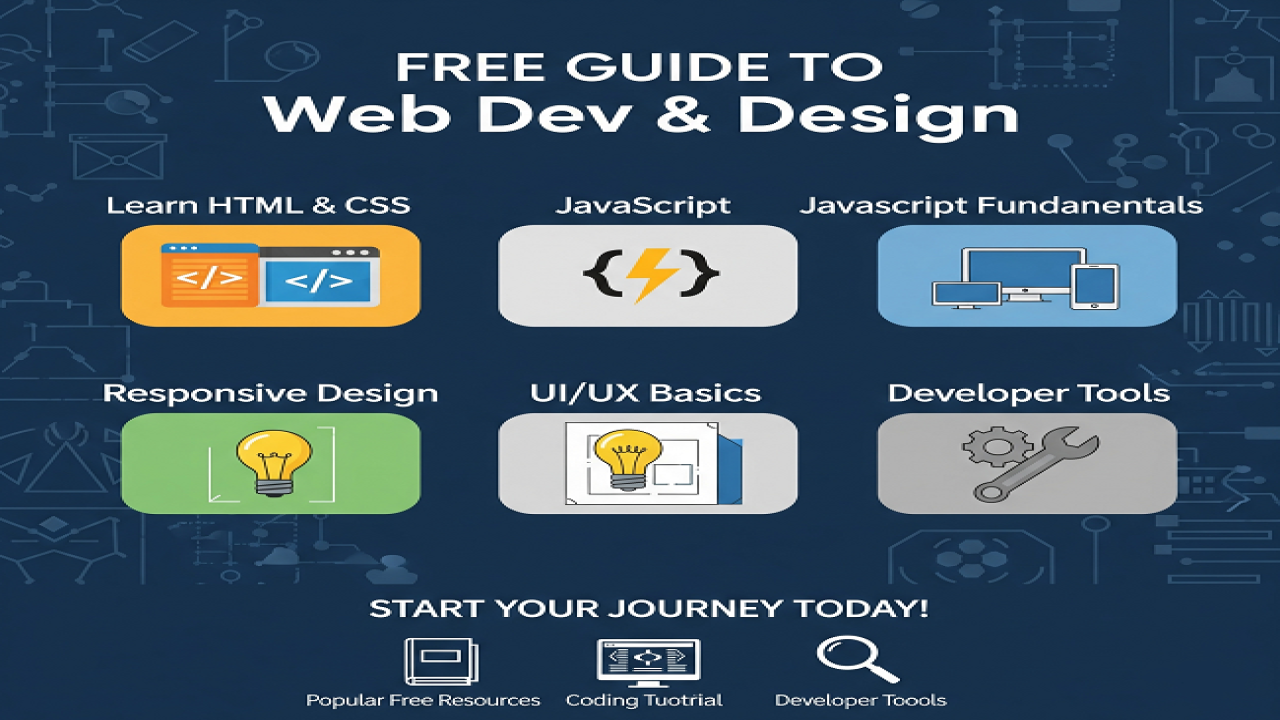The Ultimate Guide to Learning Web Development & Design for Free
In today’s digital-first world, web development and design have become essential skills. Whether you’re looking to start a career in tech, launch your own website, or explore freelance opportunities, learning web development and design can open countless doors. The best part? You can learn most of it for free, without ever attending a formal class or relying heavily on human instructors. In this blog, we’ll explore the fundamentals, the tools you need, and the best free resources available online.
Understanding Web Development and Design
Before diving into learning, it’s important to understand what web development and web design actually mean.
Web Development is the process of building websites or web applications. It involves coding, programming, and making websites functional. Developers typically focus on either the front-end (what users see) or the back-end (server, database, and functionality).
Web Design focuses on aesthetics and usability. Designers ensure that websites are visually appealing, user-friendly, and intuitive. Good design is crucial because it affects how visitors perceive a website and interact with it.
While web development emphasizes functionality, web design emphasizes experience. Learning both gives you a competitive edge, allowing you to build complete websites from scratch.
Front-End Development: Making Websites Come Alive
Front-end development refers to everything users see and interact with. The key technologies for front-end development include:
HTML (HyperText Markup Language): HTML forms the backbone of every website. It structures content into headings, paragraphs, links, images, and more.
CSS (Cascading Style Sheets): CSS adds style to websites. It allows developers to customize colors, fonts, layouts, animations, and responsiveness.
JavaScript: JavaScript brings interactivity. From dynamic forms to image sliders and animations, JavaScript is essential for engaging user experiences.
Frameworks and Libraries: Tools like React, Vue.js, and Bootstrap speed up development and simplify complex tasks.
Free Resources for Front-End Learning
You don’t need to spend a penny to get started with front-end development. Some excellent free resources include:
FreeCodeCamp: Offers an entire responsive web design curriculum. Hands-on exercises make it interactive and beginner-friendly.
The Odin Project: A full web development path including HTML, CSS, JavaScript, and Git.
MDN Web Docs: The ultimate reference for HTML, CSS, and JavaScript. It’s written by Mozilla and trusted by developers worldwide.
YouTube Tutorials: Channels like Traversy Media, The Net Ninja, and Academind provide free video tutorials covering both basics and advanced concepts.
Back-End Development: Powering Websites Behind the Scenes
While front-end developers focus on what users see, back-end developers handle the server, databases, and application logic. Key areas of back-end development include:
Server-side Languages: Common choices include Node.js, Python (Django or Flask), PHP, and Ruby on Rails.
Databases: Websites often need to store data. MySQL, MongoDB, and PostgreSQL are popular database options.
APIs (Application Programming Interfaces): APIs allow websites to communicate with other services. Learning to create and consume APIs is a valuable skill.
Server & Hosting: Understanding servers, hosting, and deployment is essential. Platforms like Heroku or Netlify make deployment easier for beginners.
Free Resources for Back-End Learning
FreeCodeCamp Back-End Development: Offers lessons on Node.js, Express, and MongoDB.
The Odin Project – Full Stack Path: Covers both front-end and back-end development in a structured way.
YouTube Tutorials: Channels like Programming with Mosh and Academind provide clear explanations and practical projects.
Online Documentation: Most back-end frameworks provide detailed documentation that is beginner-friendly.
Web Design: Creating Stunning and Usable Websites
Web design is more than making a site look pretty. It’s about creating an experience that feels seamless, intuitive, and enjoyable. Key concepts include:
UI (User Interface) Design: Focuses on the layout, buttons, colors, fonts, and interactive elements.
UX (User Experience) Design: Ensures the website is easy to navigate, responsive, and user-friendly.
Graphic Design Basics: Understanding typography, color theory, and visual hierarchy is crucial.
Wireframing & Prototyping: Planning layouts before building reduces errors and improves workflow.
Free Tools for Web Design
Figma: A popular free tool for designing interfaces and creating prototypes.
Canva: Useful for creating graphics, social media banners, and visual content.
Adobe XD Free Plan: Good for UI/UX design, wireframing, and prototyping.
Coolors: Helps you generate color palettes for your designs.
Building Projects: The Key to Mastery
Learning theory alone won’t make you a web developer or designer. The best way to solidify your skills is by building real projects. Free resources often include exercises, but adding personal projects can help you stand out.
Beginner Project Ideas:
Personal Portfolio Website
Simple Blog Platform
To-Do List Web App
Interactive Quiz
Small Business Website
Advanced Project Ideas:
E-commerce Website with Payment Integration
Social Media Dashboard
Weather App using APIs
Real-Time Chat Application
Full-Stack Web Application with Authentication
By completing these projects, you gain practical experience that employers, clients, and online portfolios value.
Learning Without Human Interaction: Self-Paced Approach
One of the most attractive aspects of modern web development and design is that you can learn it entirely on your own. Here’s how to do it efficiently:
Set a Learning Schedule: Dedicate consistent hours daily or weekly. Consistency beats intensity.
Follow Structured Curriculums: Resources like FreeCodeCamp and The Odin Project provide paths that guide you step by step.
Practice Daily: Build mini-projects or replicate existing websites.
Seek Feedback Online: Communities like Reddit’s r/webdev, Stack Overflow, and Dev.to allow you to ask questions and get feedback without formal classes.
Document Your Learning: Keep notes, GitHub repositories, and a portfolio of your projects.
Benefits of Learning Web Development and Design for Free
Cost-Effective: You don’t need expensive courses or degrees to become proficient.
Flexible Learning: Learn at your own pace, anytime, anywhere.
Career Opportunities: Web development and design skills are in high demand across industries.
Creative Freedom: Build anything you imagine, from personal blogs to complex applications.
Entrepreneurship: Launch your own website, e-commerce store, or freelance business.
Common Challenges and How to Overcome Them
Even when learning online and human-free, challenges can arise:
Overwhelm by Information: Start small with HTML and CSS before moving to JavaScript and frameworks.
Motivation Issues: Set achievable goals and reward yourself for milestones.
Debugging Problems: Use online communities, documentation, and tutorials to solve coding errors.
Staying Updated: Web technologies evolve rapidly. Follow blogs, newsletters, and YouTube channels to stay current.
Recommended Free Learning Platforms
Here’s a concise list of platforms where you can learn web development and design for free:
| Platform | What You Can Learn | Why It’s Useful |
|---|---|---|
| FreeCodeCamp | HTML, CSS, JS, React, Back-End | Interactive exercises and certificates |
| The Odin Project | Full Stack Development | Structured roadmap from beginner to advanced |
| MDN Web Docs | Web standards, HTML/CSS/JS | Official and reliable documentation |
| Figma | UI/UX design, prototyping | Create stunning interface designs |
| Canva | Graphic design | Easy-to-use tool for visual content |
| YouTube (Traversy Media, Net Ninja) | Various coding tutorials | Step-by-step video learning |
| GitHub | Version control, collaboration | Store, share, and showcase projects |
Tips to Maximize Learning
Start with Fundamentals: HTML and CSS are essential before jumping into frameworks.
Work on Projects Continuously: Each project reinforces your understanding.
Join Online Communities: Even without humans in class, peer support online is invaluable.
Experiment: Don’t be afraid to try new libraries, frameworks, and design tools.
Build a Portfolio: A strong portfolio demonstrates your skills to potential employers or clients.
Final Thoughts
Learning web development and design doesn’t have to be expensive or require formal education. With free resources available online, anyone with dedication and curiosity can master these skills. Start with the basics, practice consistently, build projects, and explore advanced tools as you grow.
Whether your goal is to land a remote job, freelance, start a personal project, or simply learn a new skill, web development and design offer limitless possibilities. And the best part? You can do it all without spending a dime, entirely self-paced, and without direct human interaction.
By combining theory, practice, and real-world projects, you’ll gain not only technical skills but also the confidence to innovate and create your own digital experiences.

 Welcome To Cloudboxx - uptoearn
Welcome To Cloudboxx - uptoearn

















Comments (0)
No comments found